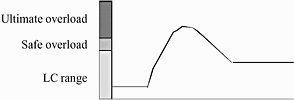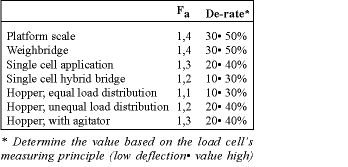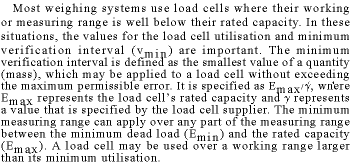
In Part I, the June issue discussed the different configuration arrangements of load cells and which configuration is best suited for which use. This issue takes a look at how one goes about determining the load cell capacity that is needed for an application and then discusses accuracy and the implications of weighing system approval.
Capacity selection
Overload is still the primary reason for load cell failure, although the process of selecting the right load cell capacity looks straightforward on first sight. Capacity selection requires a fundamental understanding of the load related terms for load cells as well as the load related factors associated with systems. The load related terms for load cells are:
* Load cell measuring range: The range of values of mass for which the result of measurement should not be affected by an error exceeding the maximum permissible error.
* Safe load limit: The maximum load that can be applied without producing a permanent shift in the performance characteristics beyond those specified; expressed as a percentage of the measuring range (ie 150%).
* Ultimate overload: The maximum load that can be applied without physical destruction of the load cell; specified as a percentage of the measuring range (ie 300%).
* Safe side load: The maximum load that can act 90E to the axis along which the load cell is designed to be loaded at the point of axial load application without producing a permanent shift in the performance beyond those specified; expressed as a percentage of the measuring range (ie 100%).
Summary
A load cell will perform within specifications until the safe load limit or safe side load limit is passed. Beyond this point, even for a very short period of time, the load cell will be permanently damaged. The load cell may physically break at the ultimate load limit.
The factors that contribute to the weight load on the load cells are: zero tracking, initial zero setting, dead load, maximum scale capacity, location and specific factors like wind forces or seismic events. In addition to these, it is often necessary to de-rate the load cells (use a higher capacity) because of:
* Shock loading.
* Dynamic influences (agitators).
* Off centre loading to the scale.
* Off centre distribution of dead load.
* The possibility of an overload weight.
The difference between normal or static overload and shock overload is often misunderstood and needs further explanation.

Static overload is defined as a gradual increase in weight over and above the rated capacity of the load cell. Shock overload can be defined as a sudden change in weight, within a very short period of time, over and above the rated capacity of the load cell. This situation specifically occurs when a relatively small nonelastic item is dropped from a considerable height onto the scale.

Systems can be protected by incorporating shock insulation pads, or by selecting load cells with a higher rated capacity. Mechanical stops act to assist the protection against shocks. Particular care must be taken with load cells that operate with a low deflection, as they are more sensitive to dynamic overload. Both types of overload result in a sudden change of zero balance; the temperature compensation on zero is also affected.

The following calculations and table should be used to calculate the correct load cell capacity:
LCcap = Ft + Fw + (deadload + liveload x Fa)/N
where:
N = Number of load cells
Fa = Dynamic load factor
Fw = Effect of wind force (for hoppers)
Ft = Combined effect of zero setting devices:
Ft = Liveload x Zero setting devices (%)/(N x 100)
For example:
A platform scale with a capacity of 1500 kg is built with four load cells. The scale has an initial zero setting of 16% and a zero tracking of 4%. The dead load equals 100 kg. The load cell capacity should be:
Ft = 1500 x (16 + 4)/(4 x 100) = 75
LCcap = [100+ (1500 x 1,4)/4] + 75 + 0 = 625 kg
Depending on the load cell's measuring principle, the required load cell capacity varies between 895 and 1250 kg (derate 30 to 50%).

It is important to verify the output per scale division with the required minimum signal level for the measuring device to ensure compatibility. The output per division (in mV) can be calculated by:
(UE x S x liveload x 1000)/(N x LCcap x n)
where:
UE = Excitation voltage
S = Rated output load cell
N = Number of scale divisions
For example, the above scale configuration is built with four load cells, output 2 mV/V, 3000 divisions, rated capacity 1000 kg and an excitation voltage of 10 V. The output per division will be:
(10 x 2 x 1500 x 1000)/(4 x 1000 x 3000) = 2,5 mV

Accuracy
Load cells are ranked, according to their overall performance capabilities into differing accuracy classes. Some of these accuracy classes are related to standards that are used in legal for trade weighing instruments, while other accuracy classes are defined by the individual load cell manufacturer. Depending on the standard and the performance of a particular load cell type, an alphanumeric 'accuracy grade' is given to the product. The alpha designate refers to the specific accuracy class, while the numeric part refers to the number of divisions. Revere Transducers manufactures products meeting NTEP, OIML and in-house specifications. These products are designated:
* Az: Products meet the NTEP requirements for class III applications.
* Bz: Products meet the NTEP requirements for class IIIL applications.
* Cz: Products meet the OIML requirements for class III and IIII applications.
* CC/D3: These are arbitrary in-house classifications for products used in nontrade applications.
Note: 'z' represents the number of divisions ('1000), ie A3, B10, C6, etc.

Approved systems
Legal for trade weighing systems require load cells which are certified according to the National Type Evaluation Program (NTEP) or OIML recommendation R60 (Europe). The requirements in terms of load cell accuracy for the abovementioned systems are:
1. Select a cell that is certified according to the appropriate standard, ie a product designated 'Az' for class III applications.
2. For each load cell, the maximum number of load cell intervals shall not be less than the number of verification scale intervals. For example, a 3000 division class III scale requires A3 load cells.
3. The minimum load cell verification interval shall satisfy the condition:
where 'e' represents the scale verification interval and 'R' represents the reduction ratio of the load-transmitting device (hybrid scales).
For example, a fully electronic scale (R = 1), with four load cells and a measuring range of 6t divided into 3000 divisions requires load cells with the following vmin
Nonapproved systems
The load cell selection for nonapproved weighing systems can be based on the specified error percentages that are indicated on suppliers datasheets. In addition, Table 2 can be used.
1. Standard systems.
2. Systems with a large dead load in relation to the measuring range, or systems that are exposed to large temperature changes.
| Tel: | +27 10 595 1831 |
| Email: | sales@instrotech.co.za |
| www: | www.instrotech.co.za |
| Articles: | More information and articles about Instrotech |

© Technews Publishing (Pty) Ltd | All Rights Reserved